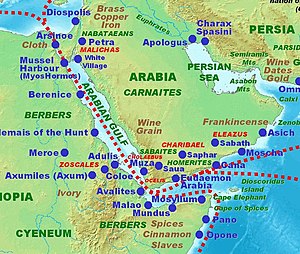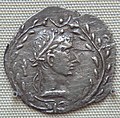Charibael

Charibael (Sabaean: 𐩫𐩧𐩨𐩱𐩡 Karibʾīl,[1][2][3] "Blessed by God",[4][5] or "Following God")[6] was a South Arabian ruler described in and contemporary with the 1st-century AD Periplus of the Erythraean Sea.
Name[edit]
The two Greek manuscripts of the Periplus give the names Greek: Χαριβαήλ, Kharibaḗl, or Χαριβαήλα, Kharibaḗla,[7] Latinized as Charibael[8] or Charibaël.[2][3] There is now widespread agreement that the name represents a transcription of the Sabaean name KRBʾL (Sabaean: 𐩫𐩧𐩨𐩱𐩡). Pace Glaser[1] & Schoff,[9] this was not a title but was a regnal name shared by numerous other South Arabian rulers.
Description[edit]


The Periplus calls Charibael the "lawful king" of the "Homerites" and "those living next to them called the Sabaites".[10] He is said to dwell in Saphar and to maintain friendship with the Roman emperors by means of "continual embassies and gifts".[10] He is said to exercise control over the towns of "Muza"[11] (Mocha)[12] and "Saua" (Taiz)[9] in "Mapharitis" through a "vassal-chief" named "Cholaebus"[13] (Kula'ib).[9] From the Roman merchants calling at Mocha, he required tribute of "horses and sumpter-mules, vessels of gold and polished silver, finely woven clothing and copper vessels".[14] His realm included "Ocelis" at the Bab-el-Mandeb[15] and the ruins at "Eudaemon Arabia"[16] but to exert little control beyond it, with the rest of the coast of the Arabian Sea peopled by nomads and fishermen,[17] the "Frankincense Country" of "Eleazus",[17] and the Parthian Empire's recent conquests in what is now Oman.[18] The Periplus credits Charibael with indirect dominion over the major ports of Azania,[19] the present-day Somali and Swahili coasts, through his vassals at Mocha.[20]
He is also probably[21] the monarch responsible for the destruction of the port of Eudaemon Arabia (Aden)[22] recently before the time of the author's voyage.[16] This was likely in service to his allies at Mocha, who would have been Aden's commercial rivals.[21] Attributing the attack to Charibael, however, requires an emendation of the text, whose manuscripts attribute the attack to "a Caesar".[22] In the 19th century, Müller[23] and Dittrich[24] emended "Caesar" to "Elisar",[22] whom they identified with the King Eleazus mentioned elsewhere in the text.[17] This has not been supported by inscriptions in South Arabia and is far less likely on geographical grounds as well.[21] Other researchers have maintained that the reference is to the invasion of Arabia by the Egyptian prefect G. Aelius Gallus in 26 BC.[25] Apart from the many decades separating that campaign from the Periplus, the detailed description of the campaign in Strabo[26] shows that the army proceeded overland and was successfully misled and sabotaged by the Nabataean patriot Syllaeus before reaching any of the southern ports. Pliny explicitly names the furthest point reached as "Caripeta",[27] usually taken after Forster[28] as a scribal error for a previously mentioned "Cariata", the Qaryatayn near Ibb in the Yemeni highlands. Pliny further explicitly states in the same passage that no other Roman force had reached so far into Arabia as late as the time of his composition of the Natural History, now usually placed well after the Periplus.
Identification[edit]


Since Glaser's 19th-century work with Arabian inscriptions,[1] Charibael is usually identified with the Kariba-il Watar Yuhan'im[9][29][30] who ruled Himyar sometime between AD 40 and 70.[9] The issue is muddied by two factors. First, the rulers of Himyar and Saba both employed the title "king of Saba and Dhu Raydan"; the title was also assumed by Hadramauti invaders around the time. The existence of such competing claims is even implied by the Periplus's own phrasing, calling Charibael the "lawful" king in probable distinction to less powerful rivals. Second, the inscriptions have revealed five different Karibʾīls during the 1st century.[2] Thus, the Periplus’s "Charibael" is sometimes identified as Karibʾīl Bayān,[31] son of Dhamarʿalī Dharib and king of Saba during the AD 80s.[32]
See also[edit]
References[edit]
Citations[edit]
- ^ a b c Glaser (1895), pp. 37–8.
- ^ a b c Shitomi (1976), p. 23.
- ^ a b Robin (1991), p. 12.
- ^ McClure & al. (1897), pp. 84–5.
- ^ Beeston & al. (1982), p. 79.
- ^ Beeston & al. (1982), p. 78.
- ^ Robin (1991), p. 9.
- ^ Schoff (1912), p. 294.
- ^ a b c d e Schoff (1912), p. 107.
- ^ a b Periplus, §23.
- ^ Periplus, §21.
- ^ Schoff (1912), p. 106.
- ^ Periplus, §22.
- ^ Periplus, §24.
- ^ Periplus, §25.
- ^ a b Periplus, §26.
- ^ a b c Periplus, §27.
- ^ Periplus, §33.
- ^ Periplus, §31.
- ^ Periplus, §16.
- ^ a b c Schoff (1912), pp. 115–6.
- ^ a b c Schoff (1912), p. 115.
- ^ Müller (1855).
- ^ Dittrich (1883).
- ^ McLaughlin (2014).
- ^ Strabo, Geogr., XVI, §§22–24.
- ^ Pliny, Nat. Hist., VI, §32.
- ^ Forster (1844), pp. 314–15.
- ^ Ryckmans (1953).
- ^ Eggermont (1968).
- ^ McLaughlin (2007), p. 7.
- ^ Robin (1997), p. 91.
Bibliography[edit]
- – via Wikisource.
- Beeston, Alfred Felix Landon; et al. (1982), Sabaic Dictionary, Beirut: Lebanese Library.
- Dittrich, Heinrich Theodor, under the pseudonym B. Fabricius (1883), Der Periplus des Erythräischen Meeres von einem Unbekannten (in Greek), Leipzig: Veit & Co. & (in German)
- Eggermont, Pierre Herman Leonard (1968), "The Date of the Periplus Maris Erythraei", Papers on the Date of Kaniṣka Submitted to the Conference on the Date of Kaniṣka, London, 20–22 April, 1960, Oriental Monograph Series, vol. IV, Leiden: Brill, pp. 94–96.
- Forster, Charles (1844), The Historical Geography of Arabia, vol. II, London: Duncan & Malcolm.
- Glaser, Eduard (1895), Die Abessinier in Arabien und Afrika, Munich: Hermann Lukaschik. (in German)
- Hommel, Fritz (1897), McClure, Edmund; et al. (eds.), The Ancient Hebrew Tradition as Illustrated by the Monuments, New York: E. & J.B. Young & Co.
- McLaughlin, Daniel (2007), Yemen, Chalfont St Peter: Bradt Travel Guides, ISBN 9781841622125.
- McLaughlin, Raoul (2014), The Romen Empire and the Indian Ocean: The Ancient World Economy & the Kingdoms of Africa, Arabia, & India, Barnsley: Pen & Sword Military, ISBN 9781783463817.
- Müller, Karl, as Carolus Mullerus (1855), "Anonymi Periplus Maris Erythraei", Geographi Graeci Minores, vol. I, Paris: Ambrose Firmin Didot, pp. xcv–cxi & 257–305. (in Greek) & (in Latin)
- Robin, Christian (1991), "L'Arabie du Sud et la Date du Périple de la Mer Érythrée (Nouvelles Données)" (PDF), Journal Asiatique, vol. CCLXXIX, pp. 1–30. (in French)
- Robin, Christian (1997), "Al-Sawdāʾ", Encyclopedia of Islam, vol. IX (2nd ed.), Leiden: Brill, pp. 90–92.
- Ryckmans, Jacques (1953), "La Chronologie Sud-Arabe du Premier Siècle avant Notre Ère", Bibliotheca Orientalis, vol. X, pp. 205–211. (in French)
- Schoff, Wilfred Harvey, ed. (1912), Periplus of the Erythraean Sea, Philadelphia: Commercial Museum.
- Shitomi, Yūzō (1976), "On the Date of Composition of the Periplus Maris Erythraei: A Study of the South Arabian Epigraphic Evidence", Memoirs of the Research Department of the Toyo Bunko, vol. 34, pp. 15–45.
